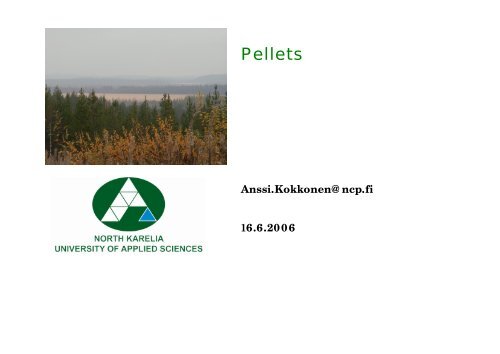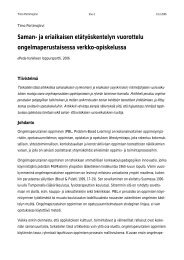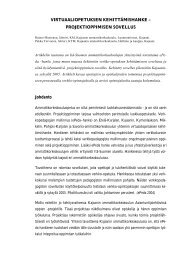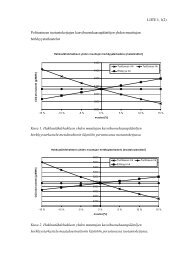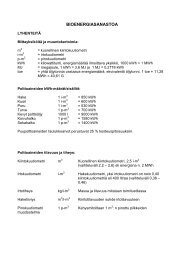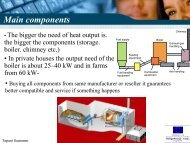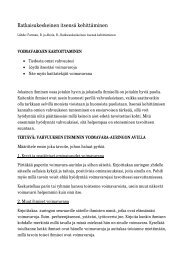Pellet Production and Use, Pdf-material
Pellet Production and Use, Pdf-material
Pellet Production and Use, Pdf-material
You also want an ePaper? Increase the reach of your titles
YUMPU automatically turns print PDFs into web optimized ePapers that Google loves.
<strong>Pellet</strong>s<br />
Anssi.Kokkonen@ncp.fi<br />
16.6.2006
Wood pellets day:<br />
8:15-10:00 <strong>Production</strong><br />
Raw <strong>material</strong>s<br />
Equipment<br />
Quality issues<br />
10:00-10:15 Coffee/Tea break<br />
10:15-12:00 <strong>Use</strong> of pellets<br />
Transportation<br />
Storage types<br />
Boilers <strong>and</strong> burners<br />
12:00-13:00 Lunch<br />
13:00- Visit to wood pellet heating plants
Some facts about wood pellets<br />
Newly discovered renewable fuel<br />
Diameter 6-10 mm <strong>and</strong> length 10-30 mm<br />
Bulk density in average 650 kg/bulk m 3<br />
(ca. 1,5 m 3 /ton)<br />
Low ash content with pure wood pellets, ca.<br />
0,5 %<br />
High energy content, 4,7 kWh/kg<br />
(2,1 kg pellets=1 l light oil=10 kWh)
Why pellets?<br />
Why to refine shavings, saw dust<br />
etc?<br />
- More dem<strong>and</strong> for by-<br />
products<br />
better price of by-products<br />
operation<br />
more profitable<br />
- Easy to transport<br />
- Clean <strong>and</strong> easy<br />
combustion
Raw <strong>material</strong>s<br />
Wood pellets<br />
main <strong>material</strong>s are shavings, cutterdust <strong>and</strong><br />
sawdust<br />
<strong>material</strong> has to be dry before pressing<br />
(moisture content preferably 50%<br />
coniferous,
Raw <strong>material</strong>s<br />
Other pellets for energy purposes<br />
Bark<br />
Peat<br />
Reed canary grass, straw, hay, grain etc.
<strong>Pellet</strong> production process<br />
Different steps in pellet production:<br />
- Screening of incoming <strong>material</strong><br />
- Drying<br />
- Separation of irrelevant <strong>material</strong>s<br />
- Milling<br />
- Mixing, steam addition<br />
- Pressing<br />
- Cooling<br />
- Screening<br />
- Packing
Source: www.akahl.de
Vapo Energy wood pellet plant, Ilomantsi, capacity 70 000 tn/a
Drum dryer
Source: www.akahl.de<br />
Flat die<br />
pellet press
Round die<br />
pellet press
Round die<br />
pellet press
Small size pellet production<br />
Small hammer mill
Small size pellet production
<strong>Production</strong> of pellets in 2005 ca. 260 000 tn
<strong>Pellet</strong><br />
packages
<strong>Pellet</strong> packages
<strong>Pellet</strong><br />
packing
Quality of pellets<br />
- Determines the price level<br />
- particular criterias for I <strong>and</strong> II class pellets<br />
- When producing pellets, the end user must be<br />
known (=markets)<br />
- small households need I class pellets<br />
- big power plants can use II class (bulk)<br />
pellets<br />
- Affects on many different things:<br />
- transportation, burner type <strong>and</strong><br />
adjustment, ash behaviour, emissions
Source: VTT Processes / Eija Alakangas, eija.alakangas@vtt.fi<br />
More info coming: www.eubionet.net
Source: VTT Processes / Eija Alakangas, eija.alakangas@vtt.fi<br />
More info coming: www.eubionet.net
Transportation<br />
Bulk pellets are transported for small<br />
households in trucks with pneumatic<br />
equipment<br />
most common way in Finl<strong>and</strong> <strong>and</strong> Austria<br />
<strong>Pellet</strong>s in big bags (normally 500 kg) or small<br />
bags (16-20 kg) are transported by truck with<br />
loader, or customers pick up the bags with<br />
trailer<br />
common way in Sweden
Pneumatic filling of pellet silo<br />
(Nursing home in North Carelia)
Transportation<br />
Refining saw dust into pellets brings logistical<br />
benefits<br />
- It is possible to have large scale<br />
production for export markets<br />
- It is possible to offer a substitute for oil<br />
Important new sectors of business in pellet<br />
production <strong>and</strong> in equipment production<br />
No loss of jobs in transportation sector
Using pellets<br />
Wood pellets are suitable for heating one-<br />
family houses, farms, block buildings…<br />
They are also used in different size heating<br />
<strong>and</strong> power plants<br />
At big power or heating plants, when using<br />
pulverized combustion, the pellets are crushed<br />
prior to feeding<br />
Conversion techniques for almost every<br />
purpose can be found (even wood gas<br />
applications etc.)
Using pellets<br />
The situation in some countries:<br />
Finl<strong>and</strong>, ca. 4 500 users<br />
Sweden, ca. 1 000 000 users<br />
Germany, ca. 45 000 users<br />
Future visions for 2010, Finl<strong>and</strong> as an example:<br />
the share of pellet heating in new houses 30 %<br />
25 000 houses with pellet heating<br />
the potential is big: ca. 250 000 one-family<br />
houses with oil heating
Using pellets<br />
Storage solutions <strong>and</strong> conveyors:<br />
Small silo for manual filling
Using pellets<br />
Storage solutions <strong>and</strong> conveyors:<br />
Big outside silo for pneumatic<br />
filling (note the checking<br />
door)
Using pellets<br />
Storage solutions <strong>and</strong> conveyors:<br />
<strong>Pellet</strong> silo for<br />
households<br />
(horizontal<br />
position),<br />
pneumatic filling
Using pellets<br />
Storage solutions <strong>and</strong> conveyors:<br />
Inside silo<br />
(horizontal<br />
position)
Using pellets<br />
Storage solutions <strong>and</strong> conveyors:<br />
Inside silo, special<br />
frame construction
Using pellets<br />
<strong>Pellet</strong> boilers <strong>and</strong><br />
burners:<br />
-”Sk<strong>and</strong>inavian type”<br />
- Boiler <strong>and</strong> burner<br />
are separate units,<br />
possible to change<br />
separately
Using pellets<br />
<strong>Pellet</strong> boilers <strong>and</strong><br />
burners:<br />
- ”Middle European<br />
type”<br />
- Boiler <strong>and</strong> burner<br />
are one compact<br />
unit, sold always<br />
together
Using pellets<br />
<strong>Pellet</strong> stove:<br />
- Automatic heating unit<br />
for household use
Problems with pellets<br />
The production is a complicated process<br />
The equipment needed are expensive<br />
The skills needed do not come from a quidebook<br />
The early stage requires special knowledge of<br />
raw <strong>material</strong>s, equipment <strong>and</strong> markets / end use<br />
Difficult entering of markets<br />
The EU wide st<strong>and</strong>ard for biofuels is not yet fully<br />
operating<br />
Undeveloped markets of heating equipment<br />
We have not enough research results to promote<br />
the markets<br />
Especially about the emissions
<strong>Pellet</strong>s in North Carelia<br />
<strong>Pellet</strong>s started to come less than 10 years ago<br />
One pellet mill (Vapo Oy, municipality of Ilomantsi)<br />
Capacity ca. 70 000 tn/a, recent investments<br />
<strong>Use</strong>rs are mostly private houses <strong>and</strong> municipalities,<br />
effect range 5-500 kW (almost 20 over 50 kW centres)<br />
Interest in pellets is strongly rising, due the high oil<br />
<strong>and</strong> electricity prices
<strong>Pellet</strong>s in North Carelia<br />
Finl<strong>and</strong>s leading areas in development of pellet<br />
sector


